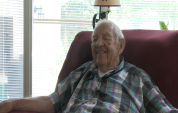4:21 | One man from the unit would get a thirty day furlough with travel back to the United States. The honor fell to Bob Seeley, who was one of the few in his unit to survive the Battle of the Bulge. He reveals why he moved back when General Eisenhower was greeting soldiers in Le Havre and why his accommodations on the crossing back to England were first rate.
Keywords : Bob Seeley Battle of the Bulge furlough Willie Herman La Havre Rodney Davis Mullens WV Dwight D. Eisenhower (Ike) shave England Southhampton

It was a new experimental branch of the Army, infantry in gliders. Bob Seeley loved to fly and had a private pilot license, so it was an exciting assignment for him. He reveals how he survived all the crashes and how he wound up at jump school without going to Fort Benning.
Once in England, Bob Seeley's glider unit began training in British gliders, with tragic results for the first aloft. At the Battle of the Bulge, his 30 caliber machine gun was overmatched by the German tanks, but he found a way to disable them. His unit suffered tremendous losses, including all the officers in the first day.
The Germans were down in a valley and the Americans were up at the top of the hill. From the German perspective, the Americans were setting a trap. On the hill, Bob Seeley didn't want to huddle down in a foxhole and freeze so he kept walking back and forth, trying to keep warm.
He went home on a 30 day furlough and never went back to Europe. Bob Seeley's leave was extended, his back problem tied him up for five months, and he was shuffled around to different bases until he wound up in Maine. Rather than face the cold, he resorted to drastic measures, reenlistment.
He could not believe how much tax was withheld from his first paycheck, so Bob Seeley went back into the Army. He began driving generals around once it was discovered he could manage the prickly personalities. He so impressed a visiting Air Force general, he was invited into a B-17 cockpit and transferred to the Air Force to serve on the general's staff.
Newly transferred from the Army into the Air Force, Bob Seeley's rapid promotion ruffled some feathers. When his commanding officer was transferred to Germany, he went with him. During this time, he helped General Eisenhower locate the site of a peculiar memory from World War I.
As the driver for the Supreme Allied Commander in Cold War Europe, Bob Seeley met some interesting people, including the Duke of Windsor, who played golf with his boss. When the new ambassador to France arrived, he turned out to be a former commanding officer.
After his son was born, Bob Seeley returned from his posting in Europe and settled into Washington with a job at the Pentagon as 1st Sergeant with the Pentagon Squadron. One of their responsibilities was ceremonial parades and no one told him that these were graded. No problem.